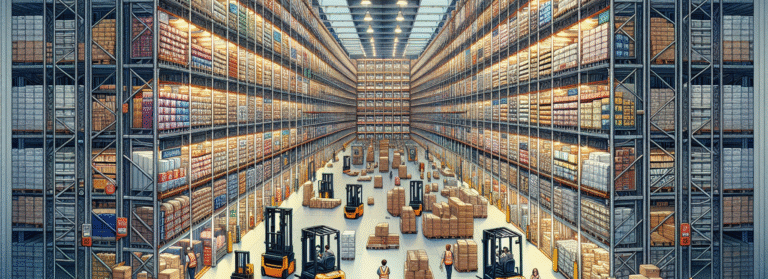Assistants and Chatbots for Warehouse Staff
AI Assistants for Warehouse Staff are no longer futuristic buzzwords. They’re becoming practical tools that help warehouse workers perform more efficiently, stay safer, and obtain answers more quickly. From guiding new hires through their first day to helping veterans troubleshoot equipment issues, AI Assistants for Warehouse Staff are reshaping how people interact with technology on the floor.
This guide explores what AI Assistants for Warehouse Staff can do, how they fit into daily operations, and why they matter for efficiency, safety, and morale.
Why AI Assistants for Warehouse Staff Matter
Warehouses run on people. Even with robotics and automation, staff still handle the majority of daily tasks: picking, packing, loading, maintenance, and safety checks. AI Assistants for Warehouse Staff are designed to support these workers directly, not replace them.
Instead of digging through manuals or waiting on supervisors, workers can:
Ask a chatbot how to complete a task.
Get real-time instructions on a headset or mobile device.
Receive reminders for safety and compliance.
Learn on the job with AI-powered micro-training.

Key Benefits of AI Assistants for Warehouse Staff
1. Faster Training and Onboarding
Hiring and turnover are constant challenges. AI Assistants for Warehouse Staff shorten ramp-up time by giving new workers instant access to instructions, diagrams, or even videos. Instead of waiting for a manager, new hires get guided step-by-step.
Example: A picker scans a location and asks the assistant, “Am I in the right zone?” The system confirms instantly, using LiDAR or vision-based sensors tied to the WMS. Mistakes are avoided before they happen.
2. Real-Time Problem Solving
When equipment goes down, the clock starts ticking — and confusion spreads fast. With AI Assistants for Warehouse Staff connected to IoT sensors, the conveyor notifies the system the moment it detects an issue.
Instead of waiting for a worker to report the problem, the AI assistant instantly analyzes the alert, provides troubleshooting steps, and, if needed, automatically escalates to maintenance. That means downtime is reduced, workers stay focused, and fixes happen faster.
3. Safety and Compliance Support
Safety rules are easy to forget in the middle of a rush. AI Assistants for Warehouse Staff can give gentle nudges — “Don’t forget PPE in this area” — or flag unsafe behavior when paired with cameras or sensors.
This doesn’t replace supervisors, but it adds another layer of real-time awareness that can prevent accidents.
4. Smarter Communication
In many warehouses, frontline staff feel cut off from supervisors. AI Assistants for Warehouse Staff close the gap by giving workers a two-way channel for updates, task changes, and questions.
Instead of radios buzzing endlessly, AI filters messages so staff only get what matters. That reduces noise and keeps focus on the task at hand.
5. Productivity and Morale
The biggest win from AI Assistants for Warehouse Staff is confidence. When workers feel supported — with instant answers and guidance — they perform faster and with fewer errors.
Supervisors also gain time back. They no longer need to micromanage basic questions and can focus on coaching, leadership, and strategy.
How AI Assistants for Warehouse Staff Work
Most AI Assistants for Warehouse Staff combine two elements:
Chatbots: Workers type or speak questions into handhelds, kiosks, or headsets. AI gives instant answers pulled from manuals, SOPs, or live data.
AI Agents: More advanced systems actively monitor conditions, push alerts, and suggest actions without being asked.

Both are powered by data — WMS, LMS, safety logs, IoT sensors. The better the data, the smarter the assistant.
Challenges of AI Assistants for Warehouse Staff
Like any new technology, there are barriers:
Accuracy: Bad data means bad advice. Training AI on clean SOPs is critical.
Adoption: Workers may resist talking to a “robot” at first. Clear training and leadership support make the difference.
Integration: AI Assistants for Warehouse Staff must plug into existing systems (WMS, HR, safety) or they risk becoming standalone distractions.
The ROI of AI Assistants for Warehouse Staff
Early adopters are seeing returns in:
Reduced training costs: New hires are productive faster.
Lower error rates: Staff guided in real time.
Improved safety: Compliance reminders prevent incidents.
Higher retention: Workers feel supported instead of left alone.
The true ROI of AI Assistants for Warehouse Staff comes from giving people confidence. When staff feel empowered, they stick around — and that saves far more than any single efficiency gain.
The Future of AI Assistants for Warehouse Staff
As the tech matures, AI Assistants for Warehouse Staff will move from basic Q&A to proactive management:
Suggesting daily labor schedules.
Alerting supervisors about risks before they become problems.
Optimizing task assignments based on real-time data.
In the near future, AI Assistants for Warehouse Staff won’t just answer questions. They’ll anticipate needs and guide staff like a digital co-worker.
Conclusion
AI Assistants for Warehouse Staff are transforming the way people work inside warehouses. They cut training time, improve safety, and boost morale by putting instant answers in every worker’s hands.
This isn’t about replacing people. It’s about equipping them with smarter tools to succeed. For warehouses facing labor shortages, high turnover, and increasing demand, AI Assistants for Warehouse Staff may be one of the most practical upgrades you can make in 2025.
Frequently Asked Questions
What are AI Assistants for Warehouse Staff?
AI Assistants for Warehouse Staff are digital tools, often chatbots or voice-enabled systems, that provide workers with real-time instructions, task guidance, safety alerts, and quick answers to operational questions. They integrate with WMS, LMS, and IoT data to support staff directly on the warehouse floor.
How do AI Assistants for Warehouse Staff improve training?
AI Assistants for Warehouse Staff make training faster and easier by guiding new hires step-by-step through tasks, answering questions instantly, and reducing reliance on supervisors. This shortens onboarding time and builds worker confidence from day one.
Can AI Assistants for Warehouse Staff improve safety?
Yes. AI Assistants for Warehouse Staff can send real-time reminders about PPE, flag unsafe behavior when paired with sensors or cameras, and guide workers through emergency procedures. This creates an extra layer of safety support alongside supervisors.
Do AI Assistants for Warehouse Staff replace managers?
No. AI Assistants for Warehouse Staff handle routine questions and task support, which frees managers to focus on coaching, leadership, and solving complex problems. They enhance human oversight rather than replace it.
What ROI can warehouses expect from AI Assistants for Warehouse Staff?
Warehouses can expect returns in reduced training costs, fewer picking errors, improved safety compliance, and higher worker retention. The real ROI comes from giving staff confidence and support, which drives both productivity and morale.






